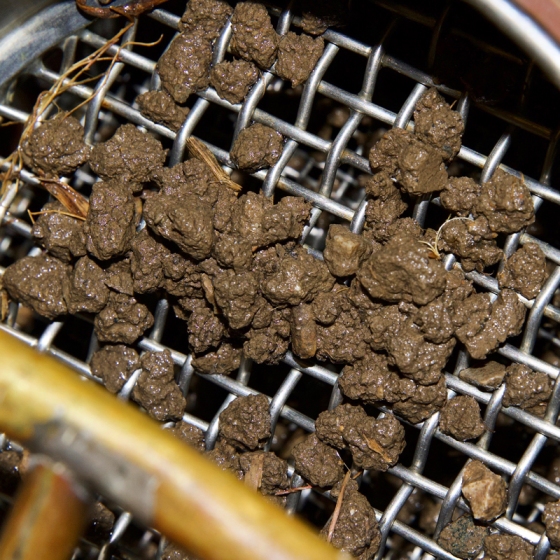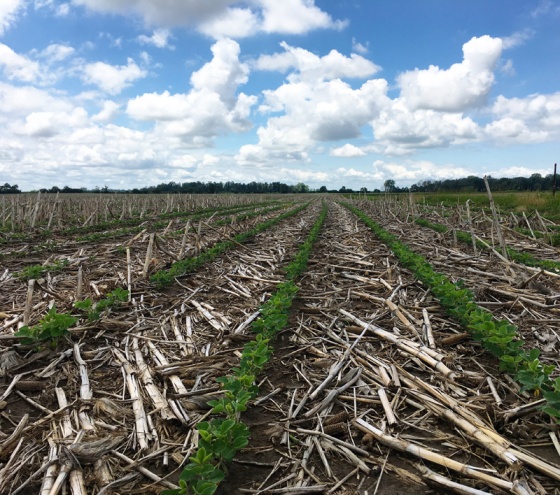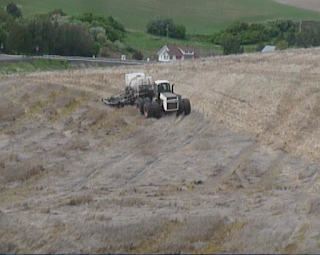The ground beneath your feet might seem like a uniform material, but it’s really a mixture of soil particles, organic matter, and other mineral/organic components. For a soil to be healthy, it must have good structure. Soil is made up of a combination of primary particles - sand, silt and clay. These particles can be bound together into what soil scientists call “aggregates.”

Soil aggregates retained on a 4.75 mm sieve after wet sieving experiment. Credit: Nall Moonilall
These aggregates are clumps of soil that range from the micro level (less than 0.25mm in diameter) to the macro level (greater than 0.25mm in diameter). Furthermore, they can resemble various shapes: granular, blocky, etc. These varied shapes allow for healthy soil to have pores spaces for air and water, needed for healthy plant growth.
Aggregate formation is a complex process. Soil aggregates are formed through physical, chemical and biological activity below ground. They are even influenced by human factors, like tilling, walking on the surface, or even how you fertilize your garden. Formation of aggregates begins with finer soil primary particles binding together. You may know that clay particles have a negative charge. And, the fertilizers you use include salts that have positively charged cations (things like potassium nitrate, etc.) The positively charged cations allow the negatively charged clay particles to bind together creating “floccules.” The type and amount of clay minerals in the soil often plays an influential role in aggregation formation.

Soil crust formation on a soil exposed to simulated rainfall. You can see the crust formation on the surface of the soil as well as how deep the crust extends. (This really is soil - not cement!) Credit: Nall Moonilall
The second part of aggregate formation deals with cementation. Here, the clay floccules and other soil particles are bonded together by some type of cementing agent. (Here we mean "binding" - not cement like in concrete!) Examples of cementing agents include organic matter, and liming materials like calcium carbonate. Even types of oxides, like iron and aluminum can help cement particles together.
In the case of organic matter, it is broken down by the soil microorganisms and soil fauna (earthworms, etc.) When breakdown occurs, these organisms secrete organic compounds that are the “glue” that makes cementation occur. Plant roots also play a role in aggregate formation by secreting organic compounds called root exudates. These help bind soil together near the root zone. Fungal hyphae also contribute to aggregate formation by entangling and weaving around soil particles.
As you can see, aggregate formation is the result of many interactions and feedback loops occurring below ground.
Soil aggregates play a major role in soil structure formation and soil health. In agriculture, the stability of aggregates is critical to how well an agroecosystem will function. The pore spaces in soil influence air and water storage, and gaseous exchange. They create habitat for soil microorganisms, and allow for plant root development and penetration. They also assist in nutrient cycling and transport.
Soils that have high aggregate stability are less susceptible to erosion. They hold their shape when exposed to disruptive forces, like water, and do not easily break apart.

Keep soil covered! Crop residues on the soil surface help to protect soil from erosive forces. Credit: Nall Moonilall
Poorly aggregated soils disintegrate easily when exposed to erosive forces. They tend to breakdown faster, leading to soil degradation. Poor stability can lead to pore spaces being filled in and can ultimately result in the formation of soil crusts. This can lead to reduced infiltration and gaseous exchange. Poorly aggregated soils can reduce crop productivity.
Soil management often influences aggregate size, shape, and stability. Favorable practices that promote and maintain greater stability include:
To recap – soil aggregates are the building blocks that make up soil and their stability is extremely important in the long-term. Soils that are well aggregated exhibit greater soil health, ensure greater agronomic productivity, are less susceptible to soil erosion, and can play a role in carbon sequestration.
Answered by Nall I. Moonilall, Ohio State University
|
Monday, July 22, 2019
WHAT IS A SOIL AGGREGATE
This is a copy and paste posting from "Soil Matter, Get The Scoop" blog. It's informative and pretty complete on the subject of soil aggregates, their value to us in the farming game, and suggested management for developing and maintaining these aggregates. This post starts out with the question of what are soil aggregates, and the reply is by Nall I. Moonilall of Ohio State.
Friday, July 12, 2019
WHY EVERY PALOUSE FARMER SHOULD NO-TILL
There is a lot going on behind the scenes relating to these issues. As an example, I am part of a Washington State Department of Ecology advisory committee being used mostly as a sounding board for staff's evaluation of NRCS best management practices. The result of this is expected to be a manual for farmers to voluntarily use to reduce pollution of state waters. I see nothing good coming out of this for farmers or the environment unless it results in a massive education push to educate farmers on the value of improving soil health. Erosion from farm land is much too complicated to be resolved with a cookie cutter manual. Over the years I have discovered that farmers generally follow tradition more than science and change is verrrrrry sloooooow. Many farm operations are the same as in the day of their grandfathers except the equipment is newer, larger and faster.
So, why should farmers no-till? The simple answer is, --WE HAVE TO! Survival in the coming political climate will depend on it. No-till is not the answer in itself, but it is the base on which to build. Minimizing soil disturbance allows for management decisions that will build soil structure, build soil surface armor, build soil organic matter, build soil biology, and minimize soil displacement. Continued use of cultivation in our Palouse environment can not accomplish these needed changes. These are all critical to improving soil health and reducing environmental degradation derived from farm operations. No-till also holds potential for sinking carbon which is beneficial to the soil and atmosphere. Our soils are carbon deficient, and carbon is a driving force in the plant kingdom. No-tilling is a WIN-WIN proposition. The trick is learning to manage the no-till system to reap the benefits and avoid the pitfalls.
Minimizing soil disturbance through no-till allows management decisions that will reduce erosion too zero or near zero. As we gain a better understanding of soil biology we will control weed species and insect predation with less chemistry. As our understanding increases about how fungal networks transports information, nutrients, and water throughout the plant community, and how soil microbes extract nutrients and make them available to plants from organic matter, dirt and rocks, we will be able to manage our crops using ever lessening synthetic inputs. The more minimal the soil disturbance the better the environment for these natural processes to develop.
Many issues surrounding SOIL HEALTH are not well understood, but there is intense research going on by private and public institutions, and farmer experimentation since around 2000. I read/listen/look at a lot of material and find myself discounting information that is more than 3-5 years old. One researcher told me that if your education in soil biology was prior to 1985 it was mostly wrong. I'm long in the tooth, but find it exciting to be part of the process. The way things are progressing, I think I will be able to experience some of the fruits associated with improved soil health before I fade away. In fact, I'm already seeing some of this happening through farm test plots but it's going to be a while before the processes are understood well enough to apply field wide. Five years ago, if someone would have asked me when we would start seeing some positive results from improved soil health I would have said, maybe my children or grandchildren.
Monday, July 1, 2019
TAKING OUT CRP
This post is prompted from watching a disaster in transitioning a CRP field back to cropping. If you want to retain the soil benefits gained during the years in CRP, the takeout process is not simple. Timing for each operation, weather, CRP cultivars in the field, crop choice, and long term goal for the field are among the factors that need consideration. Cultivating the hell out of it and planting wheat as quickly as possible puts the field back nearly to conditions prior to CRP. I'm sure the initial interest of this farmer was to save the benefits that accumulated over the years of CRP by doing a no-till conversion. This property needed the CRP benefit. It contains 6 soil types, and has a lot of shallow depth soil and suffered from OM loss through many years of cultivation and associated erosion. The mistake in my opinion was wanting to seed a cash crop too quickly without sanitizing the field. It is a very common and strong emotional pull, --to get the field producing. The takeout process started with poor fall regrowth of CRP cultivars making it impossible to get good chemical uptake. The following spring the field was chemicaled and seeded to spring barley. Seeding a grass cash crop as the first crop into an unsanitized 10 year old grass field is not a good no-till practice. The second year crop was garbanzo beans. That was OK, it gave crop diversity, except CRP cultivars were still numerous, garbs are a high moisture user, and the moisture recharge was poor. The third crop is winter wheat that was seeded very late following extensive (but not whole field) discing to remove the worst of the CRP cultivars, in a moisture depleted field. The field is still contaminated in many areas with unwanted weedy cultivars growing with the sparse stand of winter wheat. The soil structure and other soil related benefits that were built up over the years in CRP has been severely damaged. People watching this field will come to one of two conclusions depending on their preconceived attitude, (1) that no-till does not work, or (2) this field was not properly prepared for no-till.
Successful long term no-tilling requires (1) patience, (2) field sanitation, (3) crop selection to fit the conditions and limitations you have at the moment, (4) crop diversity, (5) good timing for all field operations.
Since 2002 we have taken out 4 fields of CRP. Of the four, we got the last one right. That field was given the time for proper sanitation. Other than roughness, mainly do to rodent mounds built over the years, the field is in excellent shape, with normal CRP and weedy species gone. The 2" of worm castings that make up the surface layer of the soil, soil structure and most of the other benefits developed over the years of CRP are intact. The first crop, winter wheat, was planted following an extended period of chemical fallow (sanitation period). The field was seeded with the CrossSlot drill to winter wheat looked beautiful, it was clean, and had an excellent yield. We had a companion field converted at the same time, where we spring seeded a five cultivar cover crop instead of continuing with chemical fallow. The sanitation rule for successful no-tilling was not followed and we have weed and rodent issues on that field. The field yielded approximately 10bu/ac less, which in this case was still excellent at nearly 100 bu/ac. This takeout method had two problems. (1) --was a great environment for rodents with good food source and great housing and protection from predators. They harmed numerous areas during the winter that never recovered completely leaving the field looking ragged. (2) --a number of weedy cultivars grew with the crop and increased the seed bank. Other than the abundance of rattail fescue, I'm not overly concerned about the weedy cultivars. The worm castings and soil structure are still intact from the years in CRP, and we were able to keep living roots in the ground to feed the micro biology for most of the non crop time. The question is, --over time will the benefits from this cover crop outweigh the problems that remain.
[update: 9/23/19] We have found out the hard way that weeds, where it is necessary to use harsh chemicals like Tordon (Picloram), or Stinger (clopyralid), need to be removed during the time the field is in CRP. Harsh chemicals will likely limit the cultivars available for cash cropping because of plant back issues. One of these weeds is Rush Skeleton Weed. This weed has infested thousands of acres of pasture land and CRP fields. It becomes deep rooted. There are leaves only on the ground hugging rosette. While you can reduce seed production by burning off the branching tops, you will not control it by a burn down method. Cultivation breaks up the root system and increases the density and area of infestation. The key to control is timing of application so the plant will take some of the chemistry into the root, --notably in late fall after a frost. A number of chemistries will control new plants before they establish a root system. Good control of established plants will require repeated chemical applications.
Subscribe to:
Comments (Atom)

